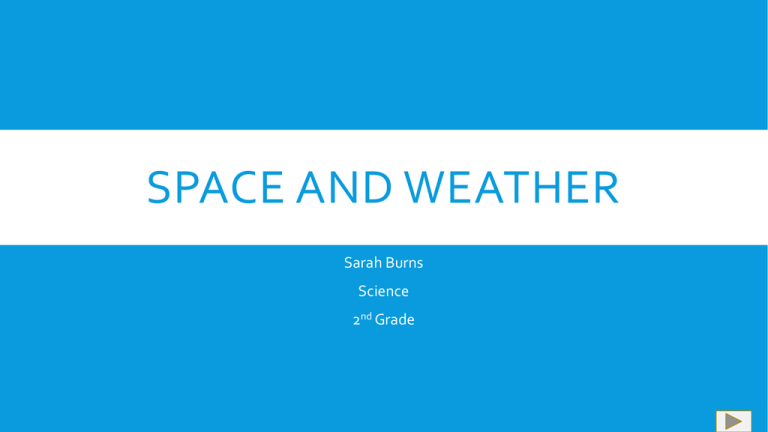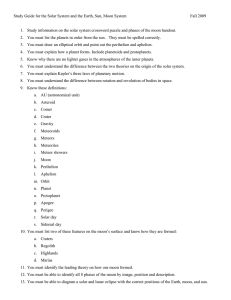Space and Weather Overview
advertisement

SPACE AND WEATHER Sarah Burns Science 2nd Grade INTRODUCTION TO THE SOLAR SYSTEM In this unit we will be learning about space and weather. We will learn about a range of topics, from stars to what causes day and night to the water cycle. There our six lessons through this presentation with quizzes throughout to test how you are learning this new information. When this unit is completed you will be able to earn a digital badge to show all of your hard work, and improvement. NAVIGATION Forward Backwards Quizzes Lessons MAIN MENU Continue to lessons! Continue to quizzes! LESSON ONE – THE NIGHT SKY A star is a big ball of hot gases. A constellation is a group of stars that form a star picture. A planet is a large ball of rock or gas that travels around the sun. STARS The hot gases of the stars give off the light that we see. Some stars seem brighter than others because they are bigger or hotter. They also may look brighter because they are closer to Earth. CONSTELLATIONS The sky has about 88 constellations. There are three very well known constellations The big dipper The little dipper And Orion the Hunter PLANETS There are eight planets, including the Earth All the planets travel around the sun Together, the sun and the planets make up our solar system LESSON ONE QUIZ 1) A big ball of hot gases is a… A. Constellation B. Star C. Planet Please Try Again! CORRECT! Move onto the next question 2) Which is one of the very well known constellations talked about in this presentation? A. Orion the Hunter B. Big Bear C. The Milky Way Please Try Again! CORRECT! Move onto the next question 3) How many planets are there in our solar system? A. Seven B. Eight C. Nine Please Try Again! CORRECT! Move onto the next Lesson LESSON TWO- DAY AND NIGHT Solar Energy Earth’s Rotation SOLAR ENERGY Like other stars, the sun is made of hot gases. These gasses are so hot they give off light and heat, which are types of energy. Most living things on Earth use solar energy. Plants use the sun’s light to make food Animals and people use its light to see in the daytime. The sun’s heat warms water, land, air, and all living things on Earth. EARTH’S ROTATION The spinning of the Earth is called its rotation. It takes 24 hours for the Earth to rotate one time; One full day. The sun is always shining, but not always on our part of the Earth. The rotation of the Earth causes each part of Earth to have light and dark each day. LESSON TWO QUIZ 1) Most living things on Earth use what from the sun.. A. Solar Energy B. Light C. Hot Gases Please Try Again! CORRECT! Move onto the next question 2) The spinning of Earth is called its.. A. Axis B. Sphere C. Rotation Please Try Again! CORRECT! Move onto the next question 3) What causes day and night? A. Rotation B. The sun C. Solar Energy Please Try Again! CORRECT! Move onto the next Lesson LESSON THREE- MOONLIGHT Moonlight THE MOON The moon seems to give off its own light. In reality, the light from the moon comes from the sun. The moon takes about 29 days to orbit the Earth. The moon has craters, which are made when a large rock moving through space hits the moon. MOON SHAPES LESSON THREE QUIZ 1) Where does the moon get its light from? A. The planets B. Earth C. The sun Please Try Again! CORRECT! Move onto the next question 2) When a rock in space hits the moon, it creates a(n).. A. Crater B. New moon C. Orbit Please Try Again! CORRECT! Move onto the next question 3) How long does it take the moon to orbit Earth? A. 29 days B. 1 month C. 1 year Please Try Again! CORRECT! Move on to the next lesson. LESSON FOUR- PHASES OF THE MOON The moon’s orbit makes the moon seems to change shape. At the start of the moon’s orbit, the moon is between the sun and the Earth. The sun shines directly on the part of the moon facing the sun, so the side facing earth is completely dark. This phase is called the new moon. As the moon orbits around the Earth, you begin to see more and more of the moon until it is a full moon. New Moon Full Moon PHASES OF THE MOON LESSON FOUR QUIZ 1) What phase is the moon in when the moon is directly between the sun and Earth? A. Full Moon B. New Moon C. Third Quarter Please Try Again! CORRECT! Move on to the next lesson. 2) Why does the moon seem to change shape? A. The moon’s orbit B. Craters C. The moon’s light Please Try Again! CORRECT! Move on to the next lesson. 3) Look at the picture. What phase is the moon in? A. Quarter Moon B. New Moon C. Full Moon Please Try Again! CORRECT! Move on to the next lesson. LESSON FIVE– WHAT CAUSES SEASONS? Earth’s Orbit Why the seasons change EARTH’S ORBIT AROUND THE SUN Earth moves in a path around the sun, called an orbit. It takes one year to orbit the sun. As the Earth orbits the sun, the seasons change. The Earth rotates on an imaginary line called an axis. A season is a time of year that has a certain kind of weather. The four seasons are: Fall, Winter, Spring, and Summer. WHY THE SEASONS CHANGE The Earth is always tilted in same direction. When Earth is on one side of the sun, part of Earth faces the sun directly and gets more sunlight. The part of the Earth is in summer. CHANGES IN WEATHER Spring Summer Fall Winter SPRING The air gets warmer Some places get rainy Warmer, wetter weather helps plants grow new leaves and flowers SUMMER Warmest time of the year Hot and sunny Storms make the weather change quickly FALL Air gets cooler Some days are cloudy, some are clear The leaves change colors and then drop off Some plants die WINTER Coldest time of the year Some places get snow Many trees and bushes have bare branches Other places it cools down Rarely have snow Trees stay green Flowers keep growing LESSON FIVE QUIZ 1) What is the imaginary line that the Earth rotates on called? A. Tilt B. Axis C. Orbit Please Try Again! CORRECT! Move onto the next question 2) Earth moves in a path around the sun called a(n) A. Orbit B. Tilt C. Axis Please Try Again! CORRECT! Move onto the next question 3) The Earth’s tilt is always in the same direction. A. True B. False Please Try Again! CORRECT! Move onto the next lesson LESSON SIX- THE WATER CYCLE Water moved from the air to the land and back to the air. The way water keeps doing this over and over is called the water cycle. HOW THE WATER CYCLE WORKS STEP 1) The sun’s heat makes water evaporate, or change into a gas. STEP 2) This gas, or, water vapor, meets cool air. STEP 3) The water vapor condenses, or changes into tiny drops of water. HOW THE WATER CYCLE WORKS (CONT.) STEP 4) The drops of water come together and form clouds. STEP 5) The water drops become heavy and fall as rain or snow. STEP 6) The rain and melted snow flakes flow into streams, lakes, and oceans. WATER CYCLE VIDEO LESSON SIX QUIZ 1) The way water moved from the air to the land over and over again is called the.. A. Water Vapor B. Evaporate C. Water Cycle Please Try Again! CORRECT! Move onto the next lesson 2) What happens to water when there is heat? A. Evaporates B. Condenses C. Becomes heavy Please Try Again! CORRECT! Move onto the next lesson 3) What happens after the water drops become heavy? A. Forms clouds B. Falls as rain/snow C. Condenses Please Try Again! CORRECT! Please move forward CONGRATULATIONS! YOU’VE COMPLETED THE UNIT OVERVIEW! Return to Title Slide






